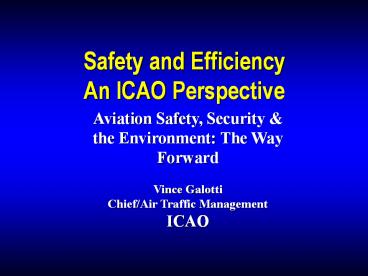ICAO Safety Management Systems (SMS) Course - PowerPoint PPT Presentation
Title:
ICAO Safety Management Systems (SMS) Course
Description:
An ICAO Perspective Aviation Safety, Security & the Environment: The Way Forward Vince Galotti Chief/Air Traffic Management ICAO Presentation Outline Two issues ... – PowerPoint PPT presentation
Number of Views:638
Avg rating:3.0/5.0
Title: ICAO Safety Management Systems (SMS) Course
1
Safety and EfficiencyAn ICAO Perspective
Aviation Safety, Security the Environment The
Way Forward Vince Galotti Chief/Air Traffic
Management ICAO
2
Presentation OutlineTwo issues
- Evolution of ICAOs efforts toward a more
seamless and global ATM system - Safety Management
3
CONTINUED EVOLUTION TOWARD A MORE GLOBAL AND
SEAMLESS ATM SYSTEM
- Global ATM Operational Concept
- Provides the ICAO vision of seamless, global ATM
system - Endorsed by 11th ANCONF
- SESAR and NexGen are adapting the concept
- Performance Based Transition
- Global Air Navigation Plan
- 23 Global Plan Initiatives
- Stems from industry roadmap
- Assists in establishment of performance
objectives - Assists in implementation of ATM operational
improvements
4
Safety Management
- How do we ensure safety in the more complex,
synchronized global system that we strive toward
5
The evolution of safety thinking
6
Concept of safety
- The elimination of accidents (and serious
incidents) is unachievable. - Failures will occur, in spite of the most
accomplished prevention efforts. - No human endeavour or human-made system can be
free from risk and error. - Controlled risk and error is acceptable in an
inherently safe system.
7
Concept of safety (Doc 9859)
- Safety is the state in which the risk of harm to
persons or property damage is reduced to, and
maintained at or below, an acceptable level
through a continuing process of hazard
identification and risk management.
8
The management dilemma
9
The big picture
- Operation of aircraft
- Maintenance of aircraft
- Air traffic services
- Aerodromes
- Two audience groups
- States
- Service providers
- Three distinct requirements
- Safety programme
- SMS
- Management accountability
10
As of 23 November 2006
- States shall establish a safety programme, in
order to achieve an acceptable level of safety
in - The operation of aircraft
- The maintenance of aircraft
- The provision of air traffic services
- Aerodrome operations
- The acceptable level of safety to be achieved
shall be established by the State(s) concerned
11
What is a safety programme?
- An integrated set of regulations and activities
aimed at improving safety. - States are responsible for establishing a safety
programme - Safety regulation
- Safety oversight
- Accident/incident investigation
- Mandatory/voluntary reporting systems
- Safety data analysis and exchange
- Safety assurance
- Safety promotion
12
As of 23 November 2006
- States shall require, as part of their safety
programme, that an operator, maintenance
organization, ATS provider, certified aerodrome
operator implements a safety management system
accepted by the State that, as a minimum - Identifies safety hazards
- Ensures that remedial action necessary to
maintain an acceptable level of safety is
implemented - Provides for continuous monitoring and regular
assessment of the safety level achieved - Aims to make continuous improvement to the
overall level of safety
13
What is an SMS?
- A systematic approach to managing safety,
including the necessary organizational
structures, accountabilities, policies and
procedures. - Providers are responsible for establishing an
SMS. - States are responsible of the acceptance and
oversight for providers SMS.
14
As of 23 November 2006
- An accepted safety management system shall
clearly define lines of safety accountability
throughout the airline, maintenance, ATS
provider, certified aerodrome operator
organization, including direct accountability for
safety on the part of senior management. - Note. Guidance on safety management systems is
contained in the ICAO Safety Management Manual
(Doc 9859). - (Accountability Obligation or willingness to
account for ones actions)
15
Safety programme SMS relationships
Protection
Production
State safety programme
Objective Public safety
Oversight
Acceptance Oversight
Organizations safety management system (SMS)
Organizations production processes
Objective Achieve commercial goals and customer
satisfaction
Objective Manage and control safety risk
Risk management Safety assurance
16
The essential is invisible to the eyes
Number of occurrences
17
Strategies Levels of intervention and tools
Safety management levels
Desirable management level
18
Risk mitigation at a glance
19
Safety culture
- A construct
- An outcome, not a process
- The introduction of safety management concepts
lays the foundation upon which to build a safety
culture - Safety culture cannot be mandated or
designed, it evolves. - It is generated top-down
20
Positive culture
Source David Marx
Flexible culture People can adapt organizational
processes when facing high temporary operations
or certain kinds of danger, shifting from the
conventional hierarchical mode to a flatter mode.
Informed culture People are knowledgeable about
the human, technical, organizational and
environmental factors that determine the safety
of the system as a whole.
Reporting culture People are prepared to report
their errors and experiences
Positive culture
Learning culture People have the willingness and
the competence to draw conclusions from safety
information systems and the will to implement
major reforms.
Just culture People are encouraged (even
rewarded) for providing essential safety-related
information. However, there is a clear line that
differentiates between acceptable and
unacceptable behaviour.
21
Summary
- The global ATM system continues to grow rapidly
- The growth will continue (environment?)
- ICAO works toward a safe and efficient growth
- Global ATM operational concept
- Global Air Navigation plan
- New approach to safety
- Proactive, predictive
- Performance based
- SAFETY MANAGEMENT SYSTEMS































